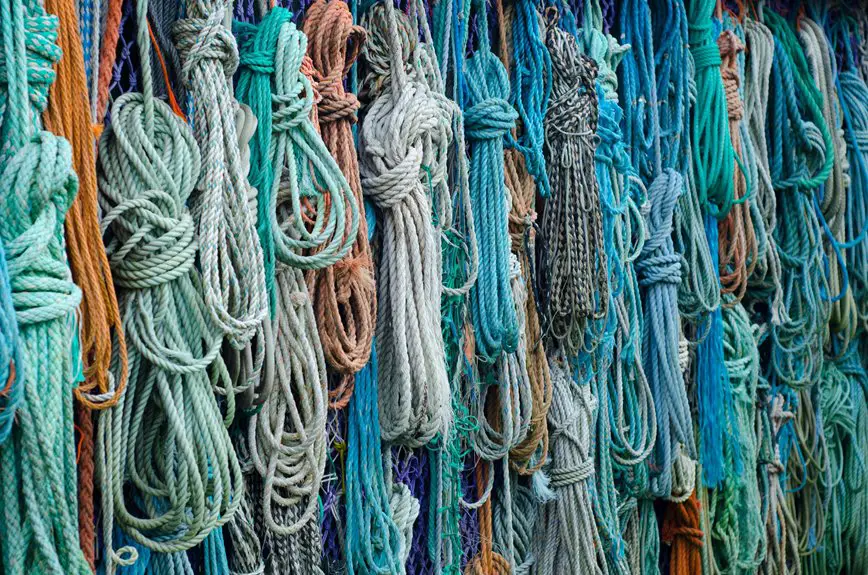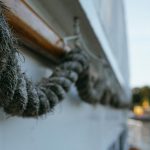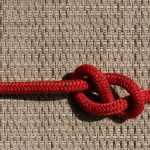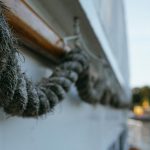When you choose Kevlar sail fabric by the yard, you get a lightweight, incredibly strong material that resists stretching, UV damage, and tearing—perfect for boosting your boat’s speed and durability. Its superior strength-to-weight ratio helps maintain sail shape under harsh winds, outperforming traditional fabrics like Dacron. Though it costs more upfront, it offers long-term savings and better performance. If you keep exploring, you’ll discover tips on purchasing, caring for, and using Kevlar sails effectively.
Table of Contents
Key Takeaways
- Kevlar sail fabric offers superior strength-to-weight ratio, ideal for high-performance sailing applications.
- It resists UV damage, stretching, and tearing, extending sail lifespan and reliability.
- Purchasing by the yard requires measuring exact yardage and selecting appropriate weight and weave for intended use.
- Buyers should source from reputable marine-grade fabric suppliers and request quality certifications and samples.
- Proper handling, storage, and regular maintenance are essential to maximize Kevlar sail durability and performance.
Understanding the Composition of Kevlar Sail Fabric
Kevlar sail fabric owes its strength to a unique chemical structure called aramid fibers. When you look closer, these fibers are long chains of molecules linked by strong hydrogen bonds, creating a tough, heat-resistant material.
The fibers align in a way that boosts tensile strength, so the fabric can handle heavy loads without stretching. You’ll find Kevlar yarns woven tightly to form the sailcloth, balancing flexibility with durability.
Kevlar yarns weave tightly, aligning fibers to enhance tensile strength, offering sails both flexibility and durability.
Unlike traditional fibers, aramid fibers resist UV damage and chemical degradation, which means the fabric stays reliable over time. By understanding this composition, you get why Kevlar is chosen for demanding sailing conditions.
It’s not just about strength but also about maintaining performance under stress, making it a smart fabric choice for serious sailors.
Advantages of Using Kevlar Fabric in Sailmaking
You’ll appreciate how Kevlar fabric combines incredible strength with lightweight performance, making your sails both durable and easy to handle.
It stands up well against environmental wear, so you won’t worry about damage from sun or saltwater.
These advantages make Kevlar a smart choice for serious sailmakers.
Strength and Durability
When you push your sail through strong winds and rough seas, you need fabric that won’t give in. Kevlar offers exceptional tensile strength, resisting stretching and tearing better than many traditional materials. This durability means your sail stays true to shape, maintaining performance even after repeated use. Plus, Kevlar resists UV damage and abrasion, extending the lifespan of your investment.
| Feature | Kevlar Fabric | Traditional Fabric |
|---|---|---|
| Tensile Strength | Very High | Moderate |
| Tear Resistance | Excellent | Fair |
| UV Resistance | High | Low to Moderate |
| Abrasion Resistance | Superior | Moderate |
| Shape Retention | Outstanding | Variable |
Choosing Kevlar means you get sails that endure the toughest conditions without compromise.
Lightweight Performance Benefits
Beyond strength and durability, the lightweight nature of Kevlar fabric plays a significant role in enhancing sail performance.
When you choose Kevlar, you reduce the overall weight of your sails, which means your boat responds faster and handles more smoothly. Lighter sails make it easier to accelerate and maintain higher speeds, especially in variable wind conditions.
You’ll also notice improved maneuverability because the reduced mass puts less strain on your rigging and hardware. This efficiency helps you harness wind power more effectively, giving you a competitive edge whether racing or cruising.
Plus, lighter sails reduce fatigue during handling and trimming, making your time on the water more enjoyable and less physically demanding.
With Kevlar, you get superior performance without sacrificing ease of use.
Resistance to Environmental Damage
Although sails face constant exposure to harsh elements, Kevlar fabric resists environmental damage better than many alternatives. When you choose Kevlar for your sails, you’re investing in durability that stands up to sun, salt, and moisture.
This fabric’s unique molecular structure provides exceptional resistance to UV rays, preventing premature fading and weakening. Plus, it won’t absorb water, so your sails stay lighter and dry faster. Kevlar’s toughness also means it can handle abrasion and wear from constant use without tearing easily.
Here’s what you can expect from Kevlar’s environmental resistance:
- High UV resistance that slows degradation
- Minimal water absorption for lighter sails
- Excellent resistance to saltwater corrosion
- Strong abrasion resistance for long-lasting durability
You’ll find Kevlar keeps your sails performing and looking better for longer.
Comparing Kevlar to Other Sail Fabrics
When you compare Kevlar to other sail fabrics, its strength-to-weight ratio really stands out.
You’ll notice how it holds up under stress better than many alternatives, but it can come with a higher price tag.
Let’s look closer at how durability and cost efficiency stack up across different materials.
Strength-To-Weight Ratio
The strength-to-weight ratio plays a crucial role in choosing the right sail fabric, especially if you want your sails to perform efficiently without adding unnecessary bulk.
Kevlar stands out by offering exceptional tensile strength while remaining lightweight, which directly enhances your boat’s speed and handling. Compared to traditional materials like Dacron or polyester, Kevlar provides a superior balance that means less stretch and better shape retention under load.
Consider these key points about Kevlar’s strength-to-weight ratio:
- Kevlar is considerably stronger per unit weight than most sail fabrics.
- Its lightness reduces overall sail weight, improving acceleration.
- Lower weight means less strain on rigging and hardware.
- Enhanced stiffness helps maintain ideal sail shape in varying winds.
Choosing Kevlar means you don’t have to compromise strength for weight.
Durability Under Stress
Beyond Kevlar’s impressive strength-to-weight ratio, its ability to withstand stress over time sets it apart from other sail fabrics.
When you put Kevlar sails through repeated tension and harsh wind conditions, they maintain shape and resist stretching far better than Dacron or polyester alternatives. This means your sails won’t deform or lose performance quickly, even after extensive use.
Unlike nylon, which can degrade under UV exposure and moisture, Kevlar boasts excellent resistance to these elements, extending its lifespan.
You’ll notice less fatigue and fewer tears in Kevlar sails, making them ideal for high-performance and racing applications where durability under continuous stress is vital.
Choosing Kevlar helps guarantee that your sails stay reliable, strong, and efficient throughout many demanding voyages.
Cost Efficiency Comparison
Although Kevlar sails come with a higher upfront cost compared to traditional fabrics like Dacron or polyester, they often save you money in the long run.
You won’t have to replace Kevlar sails as frequently because they resist stretching and fatigue better, which means fewer purchases over time.
Plus, their superior performance can reduce wear on your rigging and hardware, cutting maintenance costs.
When you factor in durability and efficiency, Kevlar offers excellent value despite the initial price.
- Longer lifespan reduces replacement frequency
- Maintains shape, improving sailing efficiency
- Lowers maintenance and rigging wear costs
- Higher resale value due to durability
How to Purchase Kevlar Sail Fabric by the Yard
When you decide to buy Kevlar sail fabric by the yard, understanding the specific requirements of your project is essential.
Start by measuring the exact yardage needed, accounting for any seams or overlaps. Next, identify the weight and weave type of Kevlar fabric that suits your sail’s performance needs.
Measure your required yardage carefully and choose the appropriate Kevlar weight and weave for optimal sail performance
Reach out to reputable suppliers who specialize in marine-grade fabrics and request samples if possible. Check for certifications that guarantee quality and UV resistance.
Don’t forget to inquire about minimum order quantities and shipping options, especially if you need smaller cuts.
Finally, compare prices while factoring in durability to get the best value. By following these steps, you’ll make an informed purchase that aligns perfectly with your sailing goals.
Care and Maintenance Tips for Kevlar Sails
After purchasing the right Kevlar sail fabric, you’ll want to keep it in top shape to guarantee it performs well over time. Proper care prevents weakening and extends your sail’s life.
Always handle your Kevlar sails gently and store them dry and out of direct sunlight. Regular inspections help catch small tears or wear before they worsen. When cleaning, use mild soap and fresh water, avoiding harsh chemicals that can degrade fibers.
Here are key maintenance tips:
- Rinse sails with fresh water after use, especially in saltwater.
- Store sails in a cool, dry place away from UV exposure.
- Avoid folding sails sharply; roll them instead to prevent creases.
- Inspect seams and fabric regularly for signs of damage or wear.
Following these steps keeps your Kevlar sails strong and reliable on the water.
Real-World Applications of Kevlar in Competitive Sailing
Because Kevlar offers exceptional strength and lightweight properties, competitive sailors rely on it to gain an edge on the water.
When you use Kevlar sail fabric, you benefit from sails that resist stretching and maintain their shape under high wind loads. This means your boat performs better during races, with improved speed and maneuverability.
You’ll find Kevlar sails especially valuable in regattas where precision and durability matter. Additionally, Kevlar’s resistance to UV damage and abrasion helps your sails last longer, reducing the need for frequent replacements.
Whether you’re competing in offshore races or inshore sprints, Kevlar’s unique qualities let you push your boat harder without worrying about sail failure.
Frequently Asked Questions
Can Kevlar Sail Fabric Be Recycled or Repurposed After Use?
You can’t easily recycle Kevlar sail fabric because of its tough fibers, but you can repurpose it for smaller projects like bags or patches. Don’t just throw it away; get creative and give it new life!
What Environmental Impacts Does Kevlar Production Have?
When it comes to Kevlar production, you’re dealing with high energy use and chemical processes that can pollute water and air. It’s not all sunshine and rainbows, so you should consider its environmental footprint carefully.
Are There Any Health Risks When Handling Kevlar Fabric?
When you handle Kevlar fabric, avoid inhaling dust or fibers, as they can irritate your skin, eyes, and lungs. Wearing gloves and a mask helps minimize these health risks during cutting or sanding.
How Does UV Exposure Affect Kevlar Over Time?
You’ll find that UV exposure weakens Kevlar fibers over time, causing them to degrade and lose strength. To protect your fabric, use UV-resistant coatings or covers to extend its lifespan and maintain durability.
Can Kevlar Sails Be Repaired if Torn or Damaged?
When your Kevlar sails catch a tear, don’t see it as a sinking ship. You can patch or reinforce them, keeping your voyage alive. With skilled hands, those damaged fibers can sail strong again.
- The Manufacturing Process of Nonwoven Polypropylene - July 11, 2025
- Is Suede Considered a Nonwoven Material? - July 11, 2025
- Is Silk a Nonwoven Fabric? - July 11, 2025







